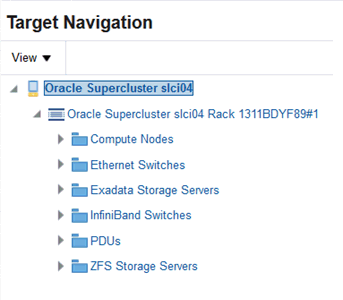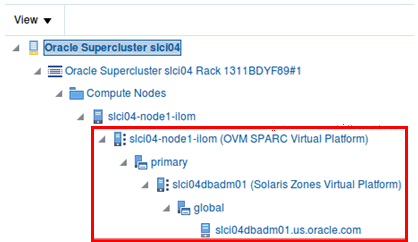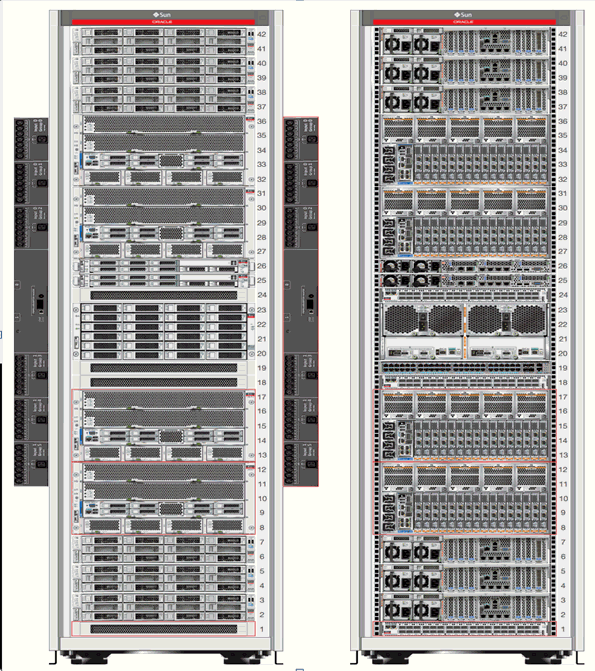37 Managing Oracle SuperCluster
The following information is included in this chapter:
37.1 Getting Started with Oracle SuperCluster
Oracle SuperCluster is an Oracle Engineered System that integrates SPARC compute nodes, an Oracle ZFS Storage Appliance, InfiniBand and Cisco switches, PDUs, and Exadata Storage Servers into a single or multi-rack system.
Oracle SuperCluster is supported in the following configurations:
-
SPARC SuperCluster T4-4
-
Oracle SuperCluster T5-8
-
Oracle SuperCluster M6-32
-
Oracle SuperCluster M7-8
To be able to start target monitoring, it is necessary to discover it. The discovery is made quick and easy with the Guided Discovery Wizard that guides you through the whole process, requests only for necessary information, and helps you solve possible issues in order to successfully complete the discovery.
37.2 Actions for Oracle SuperCluster
You can perform the following actions, depending on the requirements.
-
Discover Oracle SuperCluster
-
View the Oracle SuperCluster system
-
Monitor the Oracle SuperCluster system
37.3 Target Navigation for Oracle SuperCluster
The target navigation tree helps you to navigate between targets in the Oracle SuperCluster system. The first level under the Oracle SuperCluster consists of Racks and M-series servers. Subsequent levels consist of other hardware targets in the system which are logically grouped by their type. Figure 37-1 displays the hardware structure of the Oracle SuperCluster system. All targets are logically grouped by their type, except for the ZFS Appliance. Disk shelves are not listed in the navigation tree, see Managing Storage for more information.
Figure 37-1 Target Navigation of Oracle SuperCluster

Description of ''Figure 37-1 Target Navigation of Oracle SuperCluster''
After the Enterprise Manager Agents are deployed to the Oracle SuperCluster VM Servers for SPARC and Solaris zones, you can view the Virtualization stack for each compute node as seen in Figure 37-2. See Monitoring Oracle Solaris Zones and Monitoring Oracle VM Server for SPARC for details about the Virtualization stack.
Figure 37-2 Oracle SuperCluster Target Navigation with Virtualization Stack

Description of ''Figure 37-2 Oracle SuperCluster Target Navigation with Virtualization Stack''
37.4 Viewing the Oracle SuperCluster System
The Oracle SuperCluster landing page provides information about the system and aggregated information about the targets it contains. The page is divided into two parts. The top region consists of dashlets which provides you the general overview of the system.
The first dashlet is the Summary dashlet. It displays the summary of the system, that is, total number of most important target types (racks, switches, servers, Exadata cells).
The second dashlet displays the number of open incidents grouped by severity. Oracle SuperCluster collects incidents from all associated targets. You can get more details about incidents by clicking on the numbers in the dashlet. The details are displayed in a table with information such as Target, Summary, Last Updated, Acknowledged, and Status. You can click on a target to view more information of the particular target or click on the summary to view the details of the incident.
The third dashlet displays the time of the last configuration change and last reported incident.
The main page consists of one tab that displays the physical view of Oracle SuperCluster. Click on any target to view important information and to open the target's landing page. You can also switch to a different rack or M-series server by selecting it in the left menu (available only if there is more than one rack or M-series server in the system.)
37.4.1 Physical View of Oracle SuperCluster
Physical view of the Oracle SuperCluster system provides an overview of how the Oracle SuperCluster system is physically structured in the rack.If there is more than one rack or M-series server in the system, you can select a target from the selector available on the left side to view its detailed physical layout. (The selector is hidden if only one rack or server is present). You can click any target or component to get more information about it.If there are any incidents on a target, that particular target is highlighted by a red border to indicate it needs attention. Click on the target to view incidents grouped by severity. You can then click the severity to open the incident manager where you can further interact with the incident.
You can switch between several representations of the physical view.
-
Photorealistic view provides a realistic picture of the system, providing detailed graphics of all the components.
-
Schematic view is data oriented and displays the most important information such as locator light, status, temperature, host name. Each component in the view has its color based on the type for easy identification of the component.
-
Table view is a tabular representation of the physical view, providing a list of displayed components with the most important information.
Figure 37-3 displays the front and rear views of the Oracle SuperCluster system.
Figure 37-3 Oracle SuperCluster Rack View

Description of ''Figure 37-3 Oracle SuperCluster Rack View''
37.4.2 Virtualization Management on the Oracle SuperCluster System
For Oracle Supercluster virtualization management, the Enterprise Manager Agent has to be deployed to each of the virtualization platforms that is planned to be managed.
To monitor Oracle VM Server for SPARC, deploy the EM Agent for Host targets to the Control Domain Operating System. This agent monitors all the Oracle VM Server for SPARC resources as well as the Solaris zones configured on the Control Domain. After the Enterprise manager Agent is deployed on the guest domain operating system, Solaris zones configured in guest domains are monitored. You can install EM Agents into Control Domain and Oracle Solaris Zones using Add Host Targets wizard.
37.5 Related Resources for Oracle SuperCluster
See the following for more information: